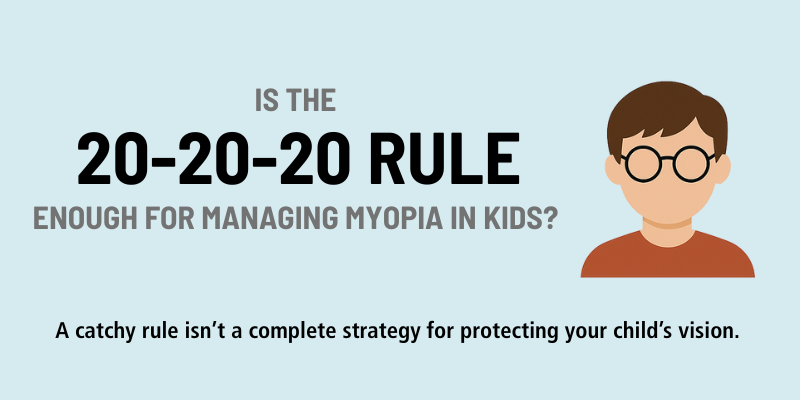Is the 20-20-20 Rule Enough for Managing Myopia in Kids?
June 16, 2025

We’ve all heard the advice: every 20 minutes, take a 20-second break and look at something 20 feet away. It’s catchy, simple, and easy to remember — but when it comes to protecting your child’s eyesight in the long run, especially from progressive myopia, this rule may not go far enough. Newer research and clinical experience suggest we need a more thoughtful approach to visual habits — especially for kids spending hours on screens or near work.
A recent article in the Review of Myopia Management suggests it’s time to rethink that rule — especially when it comes to slowing myopia progression in children.
What the 20-20-20 Rule Actually Does
The original intent of the 20-20-20 rule was to reduce digital eye strain — the fatigue, dryness, and discomfort that comes from staring at screens too long. It’s a helpful guideline to reduce symptoms like blurry vision or tired eyes during long periods of near work.
But here’s the important part: there’s no strong evidence that it prevents or slows the progression of myopia.
Myopia Progression Is About More Than Screen Breaks
Myopia (nearsightedness) is more than just a temporary eye strain issue. In children and teens, it’s a developmental condition that can worsen over time, especially with excessive near work (like reading or screen use) and lack of outdoor time.
The science now tells us that short breaks — like looking away for 20 seconds — are not enough. Myopia progression is influenced by factors like:
- Total duration of near work, not just screen time
- Visual environment (posture, lighting, viewing distance)
- Outdoor exposure, especially natural light
- Genetic risk and age of onset
What Parents Should Focus On Instead
If your child is already nearsighted or at risk of developing myopia, here are more effective strategies than relying on the 20-20-20 rule alone:
- Encourage longer breaks (5–10 minutes) from close-up work every 30 minutes — not just quick glances
- Encourage at least 90 minutes of outdoor time each day
- Use ergonomic setups at home (proper lighting, screen distance, chair height)
- Schedule annual eye exams to monitor changes in vision
- Ask us about myopia control options like orthokeratology, specialized contact lenses, or spectacle lenses designed to slow progression
Bottom Line: A Catchy Rule Isn’t a Complete Strategy
The 20-20-20 rule is a useful tool for reducing eye strain — but it shouldn’t be confused with a strategy to slow myopia progression. Instead, we recommend taking a 5–10 minute distance break every 30 minutes of near work. That gives the focusing system time to relax, especially during reading, homework, or screen time.
At Spadina Optometry, we offer personalized myopia management plans tailored to your child’s needs — because their vision deserves more than a rule of thumb.
Need help managing your child’s myopia?
Book an appointment or learn more about our Myopia Management services.
← Back to Blog
